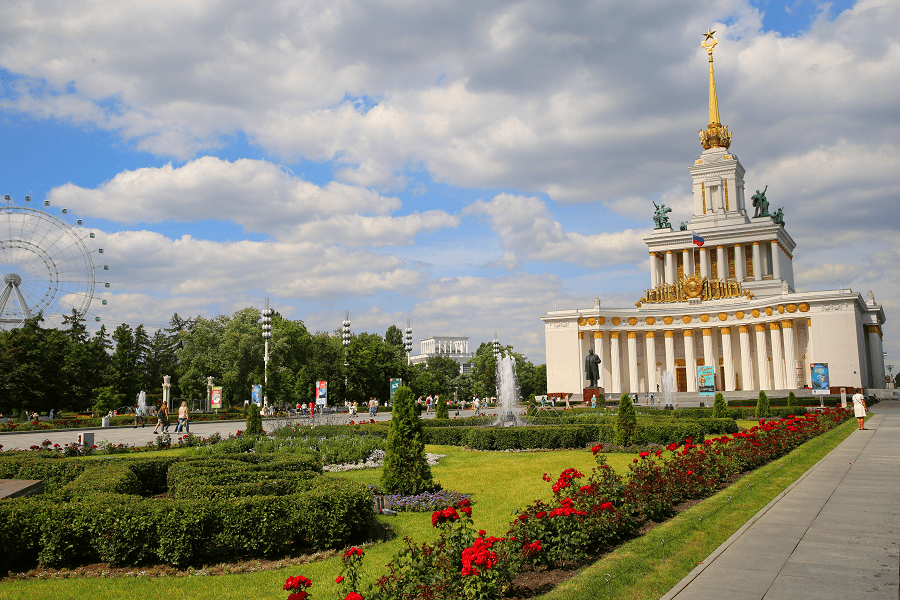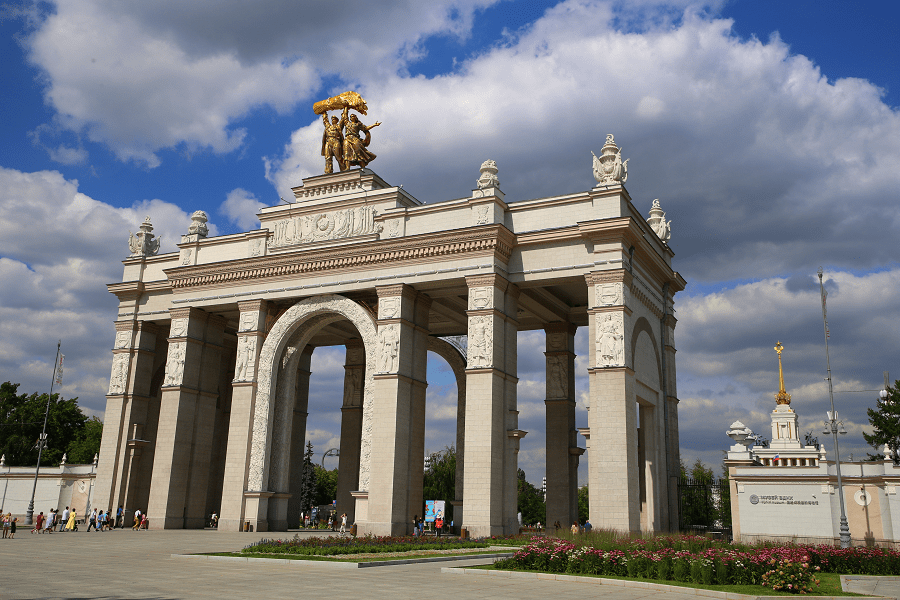Exhibition of Achievements of National Economy (VDNKh) is an exhibition complex in the Ostankinsky district of the North-Eastern administrative district of Moscow, the largest exhibition complex in the city. It is included in the 50 largest exhibition centers in the world. Every year, VDNKh is visited by 30 million guests. On August 1, 2019, the exhibition celebrated its 80th anniversary.
Geographically, VDNH has been merged with Ostankino Park and the Main Botanical Garden (since 2014). Their total area is almost 700 hectares: 240.2 hectares – the area of VDNKh, 75.6 hectares – the area of Ostankino Park, 361 hectares – of the Botanical Garden area, 9.5 hectares – of the Museum and Exhibition Center “Worker and Kolkhoz Woman” and the area in front of the Main Entrance Arch.
On the territory of the exhibition, there are many masterpieces of architecture – 49 objects of VDNKh are recognized as monuments of cultural heritage.
Created in Soviet times, they are a monument of the Soviet era, an example of architectural trends that dominated at different times.
The Exhibition of Achievements of the National Economy is a complex of buildings built with symmetry principles. Most of the pavilions were built between 1950 and 1954, already during the post-war reconstruction of the exhibition. At the same time, some of the buildings were preserved from the 1939 exhibition, and some were built after 1954.
The axis of the exhibition is two parallel alleys – Main and Central. There are two squares on the axis – Friendship of People and Industry.
The front entrance to the exhibition is located on the side of Prospekt Mira and the VDNKh metro station. An arch built in 1951-1954 marks it. After the arch, the alley leads to the Central Pavilion of the exhibition. There is a monument to Lenin in front of this area.
Behind the Central Pavilion is the Square of the Friendship of Peoples with the Friendship of Peoples fountain, which is one of the most famous attractions of the exhibition.
Some pavilions on the square and the alley that continues it were built for expositions of the Union republics or regions of the RSFSR. However, when they switched to the sectoral principle, their subject matter changed, and the pattern was violated).
The pavilion of the Ukrainian SSR closes the perspective of the alley. Next is the Industry Square, on which pavilions are dedicated (including initially) to various industries of the Soviet Union. In the center of the square is a model of the Vostok launch vehicle. Around it are samples of aviation equipment: the Yak-42 aircraft, the Mi-8t combat helicopter, the only Soviet reusable spacecraft to be launched into space Buran OK-1K1 and the Su-27 fighter.
Away from the central axis of the exhibition are smaller pavilions dedicated to other industries. To the northeast of Industry Square is the Animal Breeding Town, the pavilions dedicated to reproducing farm animals with a demonstration of live individuals.
The complex of pavilions of the Animal Breeding Town also forms a small architectural ensemble; in particular, the pavilions “Korma” and “Horse breeding” stand symmetrically to each other on the same square. A peculiar decor element of some pavilions in the Animal Breeding Town are bas-reliefs with images of farm animals on the facades.
The western part of the exhibition contains pavilions of the “Agriculture” section. Spectacular facilities, trade and catering pavilions were evenly distributed throughout the exhibition area.
Most buildings’ architectural appearance is designed according to the style that prevailed in the Soviet Union at the time of their construction. The buildings built for the 1939 exhibition were primarily designed in the Art Deco style, while those built in 1951-1954 were in the Stalinist Empire style. Ethnic motifs corresponding to the republic were often used in the republican pavilions.
There were no strict rules for the design of the pavilions. However, most were rectangular in plan, with a portico emphasizing the main facade. The coats of arms of the republics and their names in two languages – Russian and the republic’s language – were initially placed on the republican pavilions. However, they were dismantled after the exhibition switched to the sectoral display principle.
Some of the exhibition pavilions again belong to the former republics of the USSR. However, their ownership does not always correspond to the original one. For example, the former Siberia pavilion belongs to Armenia, and the former Estonian SSR pavilion belongs to Kyrgyzstan.
Unusual architectural solutions at the exhibition stand out, for example, such pavilions as “Young Naturalists,” “Tobacco,” “Nature Conservation,” and “Culture” (“Uzbek SSR”).
Some pavilions underwent reconstruction in the 1960s, changing their appearance beyond recognition. This consisted of constructing a new facade on top of the old one (the old one was preserved). The pavilions Metallurgy (the former pavilion of the Kazakh SSR), Healthcare (the former pavilion of the Armenian SSR), and Computer Engineering (the former pavilion of the Azerbaijan SSR) have undergone such changes. Now, they have been restored to their original state, Radioelectronics and Communications (the former pavilion of the Volga region), “Gas industry” (former pavilion “Potatoes and vegetables”), “Electrification” (former pavilion “Livestock”). The new facades were designed in the style of Soviet modernism.
Reconstruction
Starting in April 2014, reconstruction work at VDNKh became Moscow’s most significant public space improvement project.
Since November 2014, during the winter period (from the end of November to the first ten days of March, depending on weather conditions), the world’s largest artificial ice skating rink has operated on the territory from Peoples’ Friendship Square to the Stone Flower Fountain. It has become one of the places to celebrate the New Year. The territory of the skating rink with infrastructure facilities occupies 57,300 m², and the area of the direct ice cover is 20,510 m². Due to its size in the winter season of 2014-2015, the skating rink was included in the Russian Book of Records.
New spaces were opened in 2015 — the Moskvarium Center for Oceanography and Marine Biology, the historical park Russia — My History, the City Farm entertainment and educational center, the Chess Club and others.
In 2018, the Cosmonautics and Aviation Center was opened in the Cosmos Pavilion, the Technograd educational and leisure complex began to operate and the flagship Palace of Public Services was located in the renovated Pavilion No. 71, “Nuclear Energy.”
In January 2019, the Fairy Tale Theater was opened in the renovated Pavilion No. 9 Young Technicians. In February, workshops and art residences of the Garage Museum were in a specially converted building.
In April 2019, Pavilion No. 13, “Healthcare” (former “Armenian SSR”), was transferred to the State Museum of Oriental Art. In May, in the restored pavilion No. 58 “Agriculture” (former “Ukrainian SSR”), a modern museum, an educational platform dedicated to the history, present and future of Cyrillic writing – the Center for the Study of Writing “Slovo,” the latter placed a collection of paintings of the Roerich family in it.
In 2019, the Friendship of Peoples and Stone Flower fountains was restored. Their launch on April 30, 2019, opened the summer anniversary season of VDNKh and launched festive events in honor of the 80th anniversary of the exhibition.
In 2020, public electric transport was launched at VDNKh.
In 2021, several new projects were implemented. The Soyuzmultpark multimedia center was opened in Pavilion No. 7, and the Special Purpose Garage Museum of the FSO of Russia was opened in Pavilions No. 53–54.
The Moscow Transport Museum was opened in Pavilion No. 26. It is planned to open a trade and exhibition center of the Republic of Kazakhstan on Central Alley, which has been restored to its historical appearance of 1954.
In total, since the beginning of the VDNKh Revival program, about 20 museum and exhibition spaces have been opened, a landscape park has been created, a comprehensive scientific restoration has been conducted at 26 out of 49 cultural heritage sites and an area of more than 325 hectares has been prepared for use.
In September 2022, the coverage of the city Wi-Fi network was expanded to the territory of VDNKh. It became available throughout the central part from the main entrance arch to Industry Square and the Vostok launch vehicle. The power of 60 access points is enough to connect more than 50 thousand users simultaneously.
How to get to?
VDNKh metro station, Monorail station Exhibition Center.
See also all parks in Moscow































